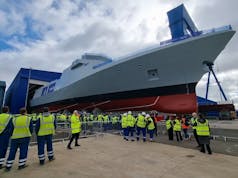Boeing say that IRST Block II provides F/A-18 aircrew with improved optics and processing power.
For the first time, Boeing and the U.S. Navy flew an F/A-18 Super Hornet equipped with an Infrared Search & Track (IRST) Block II pod in late 2019.
According to the firm:
“IRST Block II is a critical component of the Block III Super Hornet. The Block III conversion will include enhanced network capability, longer range with conformal fuel tanks, an advanced cockpit system, signature improvements and an enhanced communication system.
The updates are expected to keep the F/A-18 in active service for decades to come. IRST is a passive, long-range sensor incorporating infrared and other sensor technologies for highly accurate targeting.”
Jennifer Tebo, Boeing Director of F/A-18 Development, said:
“The IRST Block II gives the F/A-18 improved optics and processing power, significantly improving pilot situational awareness of the entire battle space.”
Currently in the risk reduction phase of development, IRST Block II flights on the Super Hornet allow Boeing and the US Navy to collect valuable data on the system before deployment to the fleet. The Block II variant will be delivered to the US Navy in 2021, reaching Initial Operational Capability shortly thereafter.
“The IRST Block II sensor gives Navy fighters extended range and increasing survivability. This technology will help the Navy maintain its advantage over potential adversaries for many years,” said Kenen Nelson, Lockheed Martin Director of Fixed Wing Programs, supplier of the IRST sensor.














The upside is as stated in the article, however as this new IRST is in the nose of the centreline tank, it becomes a permanent feature of the the F/A-18E/F rather than an option. It also decreases (slightly) the capacity of the centreline tank and as a high-end bit of kit, it would be an expensive decision if they had to ditch it during an engagement.
Always admire the way the US gets on with fully supporting their armed forces, delivering 50 Block III Super Hornets to the Navy per year from two modified production lines.
Planned replacement (F/A-XX) already in the pipeline and due in service by 2035.
I haven’t read or seen anything significant regarding the F/A-XX. Do you have any sources I can bite into?
Please see the attached link.
https://www.popularmechanics.com/military/aviation/a27396483/air-force-navy-next-generation-fighter/
Many of the sources are old and nothing much has been done on this program. I think since the US Navy is buying heaps of F-35B and the longer ranger F-35C, there’s not much chance of this program seeing production. The major case is longer range and they already admit, if that’s the case, then unmanned is the better option.
Granted the F-35 is not air combat platform, more like a BVR shoot n’ scoot. Seems like USAF and Navy won’t have a pure performance stealth air superiority fighter in future. Let’s hope we create the Tempest to outperform the Eurofighter but have stealth capabilities rivalling others. Kind of like an F-22 and a Eurofighter had a baby.
There has been a decision made at the highest levels of DOD that the future sixth generation fighter for both the Air Force and Navy will be handled more like the B-21 program in that information concerning it will be restricted while it is under development. There are a number of reasons for this but the most significant has been the threat and indeed successes of Chinese espionage and tech theft.